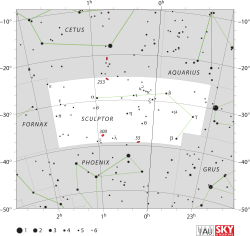Alpha Sculptoris
| Observation data Epoch J2000.0 Equinox J2000.0 | |
|---|---|
| Constellation | Sculptor |
| Right ascension | 00h 58m 36.35930s[1] |
| Declination | −29° 21′ 26.8247″[1] |
| Apparent magnitude (V) | +4.30[2] |
| Characteristics | |
| Spectral type | B7 IIIp[3] |
| U−B color index | −0.515[4] |
| B−V color index | −0.155[4] |
| Variable type | SX Ari[5] |
| Astrometry | |
| Radial velocity (Rv) | +10.2[2] km/s |
| Proper motion (μ) | RA: +20.13[1] mas/yr Dec.: +5.31[1] mas/yr |
| Parallax (π) | 4.20 ± 0.18 mas[1] |
| Distance | 780 ± 30 ly (240 ± 10 pc) |
| Details | |
| Surface gravity (log g) | 3.60[6] cgs |
| Temperature | 17,379[6] K |
| Metallicity [Fe/H] | 0.90[6] dex |
| Rotational velocity (v sin i) | 20[7] km/s |
| Other designations | |
Alpha Sculptoris (α Scl, α Sculptoris) is the Bayer designation for a star in the southern constellation of Sculptor. It has an apparent visual magnitude of +4.30,[2] which makes it the brightest star in this generally faint constellation. Parallax measurements collected during the Hipparcos mission provide a distance estimate for this star, placing it at roughly 780 light-years (240 parsecs), with a 4% margin of error.[1]
Alpha Sculptoris is a blue-white B-type giant. It is classified as an SX Arietis type variable star and its magnitude varies by less than a tenth of a magnitude.[5]
The luminosity of α Scl is around 1700 times that of the Sun while its surface temperature is 14,000 kelvins. The radius of Alpha Sculptoris is calculated to be 7 times solar while its mass is 5.5 times that of our own star. Spectral variations observed in this star where once believed to be caused by an orbiting black hole but are now known to be the result of chemical variations in its atmosphere.[citation needed]
References
- ^ a b c d e f van Leeuwen, F. (November 2007). "Validation of the new Hipparcos reduction". Astronomy and Astrophysics. 474 (2): 653–664. arXiv:0708.1752. Bibcode:2007A&A...474..653V. doi:10.1051/0004-6361:20078357.
- ^ a b c Wielen, R.; et al. (1999), Sixth Catalogue of Fundamental Stars (FK6). Part I. Basic fundamental stars with direct solutions, Astronomisches Rechen-Institut Heidelberg, Bibcode:1999VeARI..35....1W
- ^ Houk, Nancy (1979), Michigan catalogue of two-dimensional spectral types for the HD stars, vol. 3, Ann Arbor, Michigan: Dept. of Astronomy, University of Michigan, Bibcode:1982MSS...C03....0H
- ^ a b Gutierrez-Moreno, Adelina; et al. (1966), A System of photometric standards, vol. 1, Publicaciones Universidad de Chile, Department de Astronomy, pp. 1–17, Bibcode:1966PDAUC...1....1G
- ^ a b Samus, N. N.; Durlevich, O. V.; et al. (2009). "VizieR Online Data Catalog: General Catalogue of Variable Stars (Samus+ 2007-2013)". VizieR On-line Data Catalog: B/gcvs. Originally published in: 2009yCat....102025S. 1. Bibcode:2009yCat....102025S.
- ^ a b c Schmitt, A. (March 1973), "The weak-helium-line star α Sculptoris. I. The line-spectrum", Astronomy and Astrophysics Supplement, 9: 427, Bibcode:1973A&AS....9..427S
- ^ Abt, Helmut A.; Levato, Hugo; Grosso, Monica (July 2002), "Rotational Velocities of B Stars", The Astrophysical Journal, 573 (1): 359–365, Bibcode:2002ApJ...573..359A, doi:10.1086/340590
- ^ "alf Scl -- Rotationally variable Star", SIMBAD Astronomical Object Database, Centre de Données astronomiques de Strasbourg, retrieved 2012-04-08

